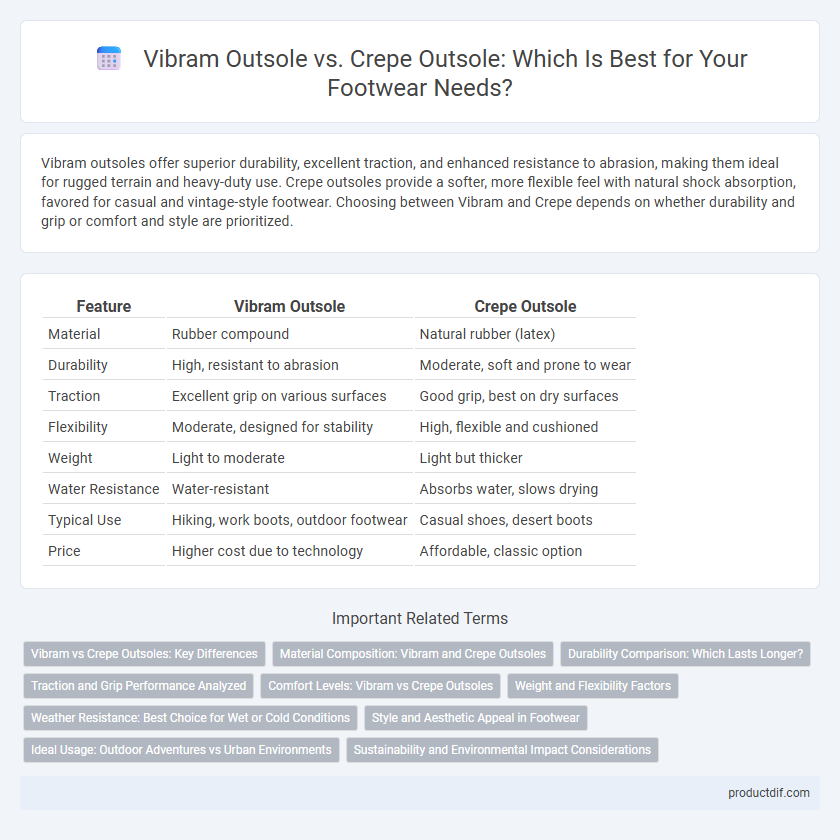Vibram outsoles offer superior durability, excellent traction, and enhanced resistance to abrasion, making them ideal for rugged terrain and heavy-duty use. Crepe outsoles provide a softer, more flexible feel with natural shock absorption, favored for casual and vintage-style footwear. Choosing between Vibram and Crepe depends on whether durability and grip or comfort and style are prioritized.
Table of Comparison
| Feature | Vibram Outsole | Crepe Outsole |
|---|---|---|
| Material | Rubber compound | Natural rubber (latex) |
| Durability | High, resistant to abrasion | Moderate, soft and prone to wear |
| Traction | Excellent grip on various surfaces | Good grip, best on dry surfaces |
| Flexibility | Moderate, designed for stability | High, flexible and cushioned |
| Weight | Light to moderate | Light but thicker |
| Water Resistance | Water-resistant | Absorbs water, slows drying |
| Typical Use | Hiking, work boots, outdoor footwear | Casual shoes, desert boots |
| Price | Higher cost due to technology | Affordable, classic option |
Vibram vs Crepe Outsoles: Key Differences
Vibram outsoles are renowned for their durability, superior traction, and resistance to abrasion, making them ideal for rugged outdoor activities and work environments. In contrast, crepe outsoles offer exceptional flexibility and comfort with a distinctive soft, cushioned feel, but they wear down faster and are less slip-resistant than Vibram soles. The choice between Vibram and crepe outsoles depends on the required balance between longevity, grip, and comfort.
Material Composition: Vibram and Crepe Outsoles
Vibram outsoles are crafted from a blend of synthetic rubber compounds designed for enhanced durability, traction, and resistance to abrasion, making them ideal for rugged outdoor footwear. Crepe outsoles consist of natural latex rubber with a distinctive crinkled texture, providing exceptional cushioning and flexibility but less abrasion resistance compared to synthetic alternatives. The material composition difference results in Vibram outsoles excelling in performance and longevity, while Crepe outsoles prioritize comfort and classic aesthetics.
Durability Comparison: Which Lasts Longer?
Vibram outsoles are engineered with durable rubber compounds that provide enhanced abrasion resistance and longer wear life, making them ideal for rugged outdoor use. Crepe outsoles, made from natural latex rubber, offer excellent flexibility and comfort but tend to wear down faster due to their softer material composition. Overall, Vibram outsoles typically last significantly longer than crepe outsoles, especially in high-impact and abrasive environments.
Traction and Grip Performance Analyzed
Vibram outsoles deliver superior traction and grip performance on diverse terrains due to their engineered rubber compounds and lug patterns, enhancing stability and slip resistance. Crepe outsoles, made from natural rubber with a softer and textured surface, provide moderate grip primarily suited for urban and casual wear but tend to wear faster on rough surfaces. Studies indicate Vibram outsoles outperform crepe in durability and grip consistency, especially in hiking and outdoor footwear applications.
Comfort Levels: Vibram vs Crepe Outsoles
Vibram outsoles provide superior cushioning and shock absorption due to their advanced rubber compounds, enhancing comfort during prolonged wear. Crepe outsoles offer a softer, more flexible feel because of their natural rubber texture, which adapts well to foot movement but may compress faster over time. While Vibram excels in durability and consistent support, Crepe outsoles deliver a uniquely cushioned sensation ideal for casual, everyday footwear.
Weight and Flexibility Factors
Vibram outsoles are engineered with lightweight rubber compounds that enhance durability while maintaining superior flexibility for dynamic movement, making them ideal for performance footwear. Crepe outsoles, composed of natural latex-based material, tend to be heavier and offer moderate flexibility, resulting in a softer, cushioned feel but less responsiveness. The weight advantage of Vibram outsoles contributes to reduced fatigue, whereas Crepe soles prioritize comfort through their pliable properties but compromise on agility.
Weather Resistance: Best Choice for Wet or Cold Conditions
Vibram outsoles excel in weather resistance by offering superior grip and durability in wet or cold conditions, thanks to their advanced rubber compounds and lug patterns. Crepe outsoles, made from natural rubber, provide moderate traction but tend to harden and lose flexibility in extreme cold, reducing performance in slippery, wet environments. For optimal safety and longevity in adverse weather, Vibram outsoles remain the preferred choice among outdoor and work footwear designs.
Style and Aesthetic Appeal in Footwear
Vibram outsoles offer a modern, rugged aesthetic favored in outdoor and casual footwear, often featuring aggressive tread patterns that enhance visual appeal and durability. Crepe outsoles provide a classic, vintage look with their natural rubber texture and soft, matte finish, commonly used in desert boots and casual shoes for a timeless style. The choice between Vibram and Crepe outsoles significantly influences the overall footwear design, balancing contemporary sportiness against traditional elegance.
Ideal Usage: Outdoor Adventures vs Urban Environments
Vibram outsoles offer superior traction and durability on rugged terrains, making them ideal for outdoor adventures such as hiking and trail running. Crepe outsoles provide a softer, more flexible sole that excels in urban environments by delivering comfort and quiet steps on hard, flat surfaces. Choosing between Vibram and Crepe depends on prioritizing performance in demanding natural landscapes versus everyday city wear.
Sustainability and Environmental Impact Considerations
Vibram outsoles, made primarily from synthetic rubber compounds, offer durability and performance but rely on petroleum-based materials affecting their environmental footprint. Crepe outsoles, derived from natural latex rubber, provide biodegradability and reduced ecological impact, making them a more sustainable option. However, crepe soles may wear faster, impacting product lifespan and sustainability assessments when compared to Vibram.
Vibram outsole vs Crepe outsole Infographic

 productdif.com
productdif.com